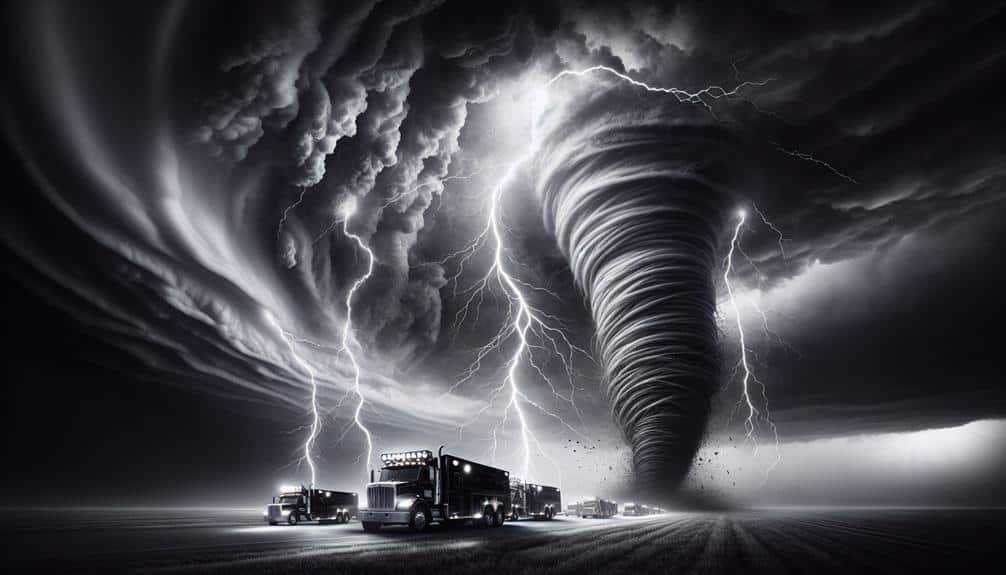Real-time storm tracking is vital for beginners because it allows us to understand the behavior of atmospheric pressure systems and moisture distribution, essential components for predicting storms. With tools like Doppler radar and geostationary satellites, we can enhance forecast accuracy and implement timely safety measures. Apps offer real-time updates, enabling informed decisions to protect lives and property. Analyzing real-time data refines our predictive models and helps us comprehend storm development in real-time. Staying connected with the community through social media guarantees everyone receives important updates. We can delve deeper into how this technology transforms storm preparedness and forecasting.
Key Points
- Real-time storm tracking equips beginners with timely warnings and safety measures to protect lives and property.
- Accurate forecasts from real-time data help beginners make informed decisions during severe weather.
- Advanced tools and mobile apps make storm tracking accessible and user-friendly for beginners.
- Beginners can learn about atmospheric conditions and storm patterns through real-time data analysis.
Understanding Weather Patterns
To effectively track storms in real-time, we must first grasp the fundamental principles of weather patterns, including the dynamics of atmospheric pressure systems and moisture distribution. Understanding these elements is vital for accurate weather forecasting and adapting to the challenges posed by climate change.
Atmospheric pressure systems, such as high-pressure ridges and low-pressure troughs, play a pivotal role in determining weather conditions. High-pressure systems generally bring clear skies and stable weather, while low-pressure systems are often associated with stormy and unpredictable weather. By monitoring these systems, we can predict where and when storms are likely to develop.
Moisture distribution is another key factor. Water vapor in the atmosphere is essential for cloud formation and precipitation. Areas with high moisture content are more prone to severe weather events. As climate change alters global moisture patterns, we're seeing shifts in storm frequency and intensity.
Enhancing Safety Measures
By leveraging our understanding of weather patterns, we can enhance safety measures to mitigate the impact of real-time storm events. Accurate storm tracking enables us to increase safety awareness, ensuring that individuals and communities are well-informed about impending severe weather. When we monitor storm data in real-time, we can issue timely warnings and advisories, which are pivotal for initiating emergency preparedness protocols.
Our ability to predict storm behavior with precision allows us to implement targeted safety measures. For instance, we can designate evacuation routes and shelters based on the storm's projected path. Additionally, real-time data helps us coordinate with local authorities and emergency services to deploy resources efficiently, ensuring that aid reaches those in need swiftly.
Furthermore, real-time storm tracking empowers individuals to make informed decisions. By staying updated on storm developments, we can avoid hazardous areas, secure our homes, and gather essential supplies. This proactive approach not only safeguards lives but also minimizes property damage.
Improving Prediction Accuracy
Advancements in meteorological technology and data analytics have greatly improved our ability to predict storm behavior with enhanced precision. By leveraging sophisticated data analysis tools, we can now interpret vast amounts of atmospheric data, including temperature, humidity, wind speed, and pressure patterns, to generate more exact storm forecasts. This improved forecasting capability allows us to provide timely and accurate warnings, thereby empowering individuals to make informed decisions and safeguard their safety.
We utilize high-resolution satellite imagery, Doppler radar, and computer models that simulate storm dynamics to predict the path and intensity of storms with remarkable accuracy. The integration of machine learning algorithms further refines these predictions by analyzing historical storm data and identifying patterns that may not be immediately obvious. This combination of advanced technology and robust data analysis greatly enhances our predictive capabilities.
Accurate storm prediction is vital for minimizing disruptions and reducing the risk to life and property. By improving forecasting accuracy, we enable communities to implement proactive measures, such as evacuation plans and resource allocation, well in advance of a storm's arrival. The ability to predict storms with high precision not only guarantees our freedom to prepare effectively but also lessens the potential impact of severe weather events.
Tools for Real-Time Tracking
We must utilize essential tracking devices like Doppler radar and satellite imaging to gather real-time data on storm movements and intensities.
Integrating this data with mobile apps allows us to provide immediate, location-specific alerts to users.
This combination enhances public safety by ensuring timely and accurate information dissemination.
Essential Tracking Devices
Leveraging advanced satellite technology and Doppler radar systems, we can achieve unprecedented accuracy in real-time storm tracking. These necessary tracking devices are vital for emergency preparedness, enabling us to take proactive measures before severe weather strikes.
Our primary tracking tools include geostationary satellites, which provide continuous data from a fixed position relative to Earth, offering high-resolution imagery essential for storm analysis. Complementing this, Doppler radar systems detect precipitation, wind speed, and velocity, delivering real-time data that allows us to monitor storm development and movement meticulously.
Data visualization plays a pivotal role in interpreting this complex data. Advanced monitoring systems translate raw satellite and radar information into comprehensible maps and models. These visual tools help us discern patterns, predict storm paths, and issue timely warnings.
For instance, mesocyclone detection algorithms within Doppler radar systems identify rotation in thunderstorms, a precursor to tornado formation, thereby enhancing our emergency preparedness.
Additionally, ground-based weather stations and buoy networks augment our understanding by providing localized atmospheric data. Combining these diverse data streams into integrated monitoring systems ensures a holistic view of storm dynamics.
With these sophisticated tracking tools, we can empower ourselves with the knowledge needed to maintain our safety and freedom during severe weather events.
Mobile App Integration
Integrating mobile apps into our storm tracking toolkit allows us to access real-time weather data directly from our smartphones, enhancing our ability to respond swiftly to severe weather conditions. These apps provide a plethora of functionalities, such as radar imagery, weather alerts, and predictive analytics, which are essential for beginners in storm tracking. With features like GPS-based location services, we can receive hyper-localized updates, ensuring that we stay informed about weather changes specific to our immediate surroundings.
App functionality extends beyond basic data presentation; many apps offer interactive maps and customizable alerts, increasing user engagement. These capabilities allow us to tailor the information to our specific needs, making the experience both user-centric and efficient. For instance, setting up notifications for specific weather events, like tornados or flash floods, empowers us to take timely protective actions.
Moreover, the user interface of these apps is designed to be intuitive, ensuring that even those new to storm tracking can navigate easily. By integrating scientific data with user-friendly design, mobile apps democratize access to essential weather information, granting us the freedom to make informed decisions independently. This integration ultimately elevates our storm preparedness, making real-time tracking both accessible and practical.
Learning From Real-Time Data

By analyzing real-time storm data, meteorologists can enhance predictive models and improve the accuracy of weather forecasts. This process is pivotal for beginners in meteorology, as it allows us to engage in interactive learning and hands-on data analysis. Real-time data provides a dynamic educational platform, enabling us to observe the immediate impacts of various atmospheric conditions on storm development and progression.
Through meticulous data analysis, we can identify patterns and anomalies that static historical data mightn't reveal. Access to up-to-the-minute information empowers us to make swift, informed decisions, thereby refining our predictive capabilities. By comparing real-time observations with model outputs, we can iteratively update and validate these models, ensuring they remain robust and reliable under varying conditions.
Interactive learning tools, such as live radar feeds and real-time satellite imagery, foster a deeper understanding of meteorological phenomena. These resources help us visualize complex processes, from cloud formation to precipitation dynamics, in real time. Consequently, we can develop a more intuitive grasp of weather systems and improve our forecasting skills.
In essence, real-time storm tracking isn't just about immediate predictions; it's an invaluable educational tool that enhances our analytical proficiency and deepens our comprehension of meteorological science.
Connecting With the Community
Utilizing real-time storm data not only sharpens our forecasting skills but also enables us to effectively communicate crucial information to our communities, fostering greater awareness and preparedness.
When we actively engage with our community, we can disseminate critical updates swiftly, making sure that everyone stays informed about imminent weather threats. This real-time data becomes a catalyst for community engagement, empowering us to share accurate information and actionable advice.
Through social media outreach, we can leverage platforms like Twitter, Facebook, and Instagram to deliver timely updates and engage in two-way communication with our audience. This instant connectivity allows us to address concerns, debunk misinformation, and provide real-time storm tracking insights. By maintaining an active presence on social media, we foster a sense of trust and reliability within the community.
Moreover, crowd-sourced data from community members can enhance our storm-tracking efforts. When individuals share their observations and experiences, it enriches the data pool and enables more precise forecasting. This collaborative approach not only improves our technical capabilities but also strengthens community bonds.
Engaging with the community in this manner makes sure that we all work together towards a common goal: safeguarding lives and property during severe weather events.
Frequently Asked Questions
What Are the Basic Terminologies Used in Storm Tracking?
Understanding storm tracking starts with learning basic terminologies like weather patterns and meteorology basics. We use Doppler radar to detect precipitation, and atmospheric pressure changes to predict storms. These tools help us stay safe and informed.
How Can Beginners Identify Reliable Sources for Storm Tracking Information?
We can identify reliable sources for storm tracking by evaluating credibility through peer-reviewed research and official meteorological agencies, ensuring we're avoiding misinformation. Cross-referencing data from multiple reputable platforms enhances accuracy and our confidence in the information.
What Is the Difference Between a Storm Watch and a Storm Warning?
Storm preparedness and safety hinge on understanding the difference: a storm watch means conditions are favorable for severe weather, prompting vigilance. A storm warning indicates confirmed severe weather, urging immediate action. Weather monitoring and alerts aid in readiness.
Are There Any Mobile Apps Recommended for Real-Time Storm Tracking?
For real-time storm tracking, we recommend mobile apps like RadarScope and Weather Underground. These apps provide detailed weather radar data and timely emergency alerts, helping us stay informed and make quick decisions to guarantee our safety.
How Can One Get Started With Storm Tracking as a Beginner?
Did you know 70% of storm chasers use mobile apps? To start storm tracking, we should focus on storm chasing, follow safety tips, learn storm spotting, and gather essential equipment needed like radar, GPS, and weather radios.
